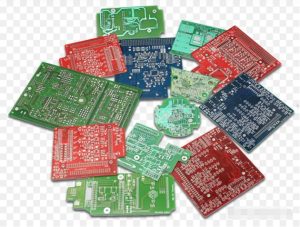PCB color is the pigmented lacquer that manufacturers coat printed circuit boards with. This is usually the color of solder mask. But there’s also another layer called silkscreen. Since these layers are differently colored for trace and other visibility, well start by looking at the options for each.

PCB Solder Mask Colors
Solder mask is the thin layer that’s used to cover the copper traces. This layer shields the board from damage and short circuits. But while solder mask is traditionally green, it isn’t the only color that manufacturers can use. Other common PCB solder mask colors include yellow, black, white, yellow, red and purple.
PCB Silkscreen Colors
PCB silkscreen is the layer that manufacturers use for labeling and component symbols, making them easy to identify. This layer is also used to show other information such as that of manufacturer. The most common PCB silkscreen colors are black and white, although other options such a blue are also used.
PCB Color Meaning
The color of a circuit board is determined by its solder mask. And while the traditional board is typically green, other colors are also possible. When ordering a PCB for your project, therefore, you may want it customized to your preferred choice. But should circuit board color matter?
Does PCB Color Matter?
It does. The right PCB color can mean many things. For instance, the silkscreen must contrast with the solder mask. This is meant to ensure trace visibility or information readability during inspection or repair.
On the other hand, you may want a PCB that looks visually appealing, or one that identifies with your product. Manufacturers may also choose a PCB color that aligns with their brand, and offer such unless otherwise specified. All these needs make choosing the right color a critical aspect of your PCB project.
PCB Color Code
In the electronics industry, PCB colors are denoted by various codes. Manufacturers use them to distinguish one color from the other, thereby ensuring changes are captured and specifications ensured. Common PCB color codes are given below.
• Green 008C4A
• Red D0011B
• Yellow F6A624
• Blue 4990E2
• Black 000000
• White ECECDF

PCB Colors
Here is a look at the different colors that you can choose from for your circuit board. Note that each color has its benefits or downsides, and these will be deeply discussed to make your decision-making easier. The different types of PCB solder mask colors are:
Green PCB
This is the traditional printed circuit board color, and what many people are used to. Green is often preferred due to its universal appeal. Many companies use it as the default choice, too. But green PCB color also offers the benefit of high contrast that makes the silkscreen visible.
That being said, a green PCB may not make a good color for branding, given its universal nature when it comes to circuit boards. In such instances, one may want to choose a different color. These are listed below.
Red PCB
Red PCB color is a vibrant choice that can make your circuit boards bold and more outstanding. But, despite its striking appeal, red PCB color may not blend well with that of the silkscreen layer, which must not be overpowered by the solder mask.
Because of its bright nature, red PCB boards are often used in combination with differently colored boards to make certain parts of a circuit distinguishable. During the manufacturing stages also, manufacturers often use red prototype boards to make them distinct.
Yellow PCB
Yellow PCB is a visually unique choice. A lot more likely to contrast with the silkscreen color, it offers good trace visibility. So it’s a color you may want to go for if looking both style and track visibility.
Yellow PCB solder mask will also work well with either white or black colors for the silkscreen, which makes it a versatile option for most circuit boards.
Blue PCB
Blue is also one of the most common PCB colors, coming second after green in terms of popularity. Blue circuit boards are mostly preferred for their good aesthetics and contrast with the silkscreen and traces, which ensures track visibility and information readability.
Besides standard circuit boards, you’ll find the blue solder mask on most Arduino boards. Some LCD boards too. Many manufacturers also use it for pre-production boards, mainly as a way of distinguishing them from other PCBs.
Black PCB
Even though the black PCB is becoming a common option today, it doesn’t perform well when it comes to inspection, especially in poor light conditions; you need to directly shine light to it for track visibly.
On the other hand, black PCB solder mask offers excellent readability of the silkscreen when combined with white, so it still remains a usable choice. In terms of functionality, the black PCB is mostly preferred for LED devices.
White PCB
White PCB solder mask has its up and downsides. In terms of visual appeal, it looks clean and high-end, although that would also depend on personal taste. On the downsides, it makes traces less visible. It’s also more difficult to inspect using a light, since it reflects the light and causes glare.
That being said, white is a preferred option for some PCBs, such as those that will be used on lighting devices. For example, you may want it for a display screen or LED light boards. For better contrast, white PCB solder mask is best used with black silkscreen.
Purple PCB
Purple is rarely used. When chosen, it’s mostly either for its uniqueness (depending on personal taste) or as a way of asserting one’s brand. If you’re going to opt for a purple PCB, weigh its benefits against the disadvantages. For example, it doesn’t offer good trace visibility or silkscreen readability, which can be a problem when it comes to board inspection.
It depends. As we’ve seen, the right PCB color ensures that your board’s traces, planes and spaces are clearly visible during inspection or troubleshooting, and that the silkscreen information is easy to read. So you want a color that offers excellent contrast with that of the silkscreen layer.
Some applications may also require certain PCB solder mask colors. Lighting applications such as displays or LED light for example, may work well with white or black PCB colors.
Apart from the functional aspects, you want a color that’s visually appealing— and if need be, one that enhances your brand, such as the color of your company’s logo.
Overall, green has proved to be one of the best PCB color choices for most applications. Green PCB are also the most cost-effective, because the large amount of material used makes the cost low. Others, such as blue and red are also good choices, as well as black and white if you’re using the board for lighting applications.
